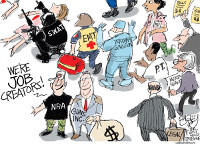
When random mass murder and ecological disaster merge, the level of suffering can be incomprehensible. The death toll in November from California wildfires has now reached 87, with 500-plus still missing. Thirteen people were gunned down November 7 at a Thousand Oaks Bar & Grill — including Carpinteria’s Mark Meza — 12 others were wounded. The country continues to grieve and attempt to comprehend the loss of 11 worshippers in a mass shooting at Pittsburgh’s Tree of Life Synagogue.
The number of mass shootings in the U.S. this year has already reached 323, as many as days in 2018. In 2017 there were 273 mass shootings. A mass shooting is four or more killed. These numbers do not reflect the number of suicides; more than 60 percent of the 38,000-plus gun deaths in America are suicides. The remainder of gun deaths are homicides, often in domestic violence situations and so-called accidents that take the lives of young children. There is currently a website solely devoted to American gun death information: gunviolencearchive.org/.
The Annals of Internal Medicine published a set of guidelines, 11-14-2018, by the Health and Public Policy Committee of the American College of Physicians (ACP) addressing the problem of firearm-related injuries and death from a public health perspective. The National Rifle Association (NRA) rebuked the ACP — and physicians in general —on Twitter, saying: “Someone should tell self-important anti-gun doctors to stay in their lane.” In response, medical professionals created viral hash-tags, #ThisISMyLane and #ThisISOurLane, sharing vivid stories of their clinical experiences with gunshot wound victims, arguing that despite what the NRA might believe, the issue falls unavoidably into the laps of medical practitioners.
“More Americans have died from gunshots in the last 50 years than in all of the wars in American history. Since 1968, more than 1.5 million Americans have died in gun-related incidents, according to data from the U.S. Centers for Disease Control and Prevention. By comparison, approximately 1.2 million service members have been killed in every war in U.S. history, according to estimates from the Department of Veterans Affairs and icasualties.org.” (Chelsea Bailey, NBC reporter)
These mass-shooting horrors happen far more in America than in other advanced countries partly because of the influence of the NRA, which says its sole priority is defending the Second Amendment. Politicians’ inaction on curbing gun violence has nothing to do with the Second Amendment and everything to do with the NRA’s checks that line their pockets. Elected leaders who put NRA donations over the lives of our children must be voted out. NRA works to defeat any politicians who back gun safety measures of any sort.
The New York Times recently analyzed a century of NRA magazine covers to show how they evolved from an apolitical association of hunters and sportsmen to a powerful lobbying group, hell bent on giving everyone easy access to guns — even dangerous people.
When we read about the numbers of mass shootings this year, the numbers of people shot, the numbers of children killed by guns, the numbers of suicides and domestic violence tragedies, these are not just numbers. Each number has a face, a loved one, family, friends and co-workers. Every time there is another shooting, these survivors relive their grief.
When the shock of these needless tragedies becomes personal, your life is forever changed. Yet for those of us who are four, five, or six degrees away from that unforgiving pain, what is our reaction? There must be an imperative to honor those lost and those grieving through #HonorWithAction.
The reality of death by gun is a message: We are all affected by gun violence. This is not a political problem, but a public health and safety problem. The increasing annual toll of death by gun is traceable to the lethality of today’s firearms. Easy access to them has also increased; in 40 percent of guns sold, buyers do not go through background checks. Worse, the most popular firearm is a semiautomatic, which shoots more bullets in a fixed amount of time and is twice as deadly as other firearm.
The Coalition Against Gun Violence (CAGV), a Santa Barbara County calition and grassroots nonprofit since 1994,invites you to join and support with action. CAGV and the Unitarian Society of Santa Barbara is hosting an Interfaith Vigil on Sunday, December 9, at 5:30 p.m., as part of the 6th Annual National Vigil for Victims of Gun Violence. The Santa Barbara Vigil is part of a nationwide effort to #EndGunViolence in America. For more information and details, see our website: sbcoalition.org, or contact cagvsb@gmail.com, or call (805) 564-6803.
Toni Wellen chairs the Santa Barbara Coalition Against Gun Violence.

 on Google
on Google 

